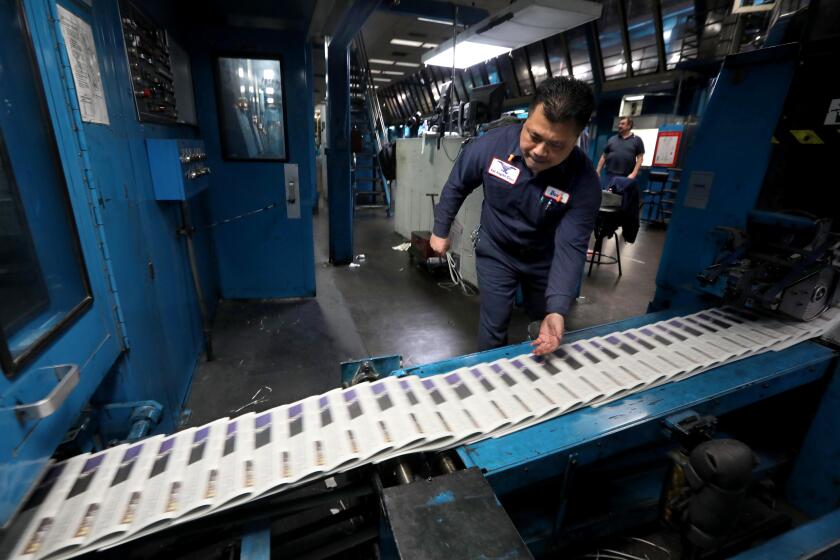Redistricting Suit Sparks Latino Political Interests
Congressman Esteban E. Torres, the La Puente Democrat, is setting up an informal exploratory committee to gauge his chances. Los Angeles City Councilman Richard Alatorre is openly courting the race. And Councilwoman Gloria Molina, herself interested, calls the potential power “marvelous.”
All of this for a political contest that, as yet, is only scheduled in the dreams of Los Angeles County Latinos. No one knows if it will be--much less when. But that has not stopped efforts to lay the groundwork for an election that could set new standards for Los Angeles in terms of attention, expense and political combustion.
The coveted position is that of Los Angeles County supervisor, and a Latino challenge to incumbent Pete Schabarum is one of the possible results of a historic redistricting trial now under way in Los Angeles federal court. The trial’s conclusion may be months away, but already political antennae are up and quivering all over the county.
Asked which politicians were watching the trial with an eye toward their own advancement, Assemblyman Charles M. Calderon (D-Whittier) offered wryly, “Every Hispanic officeholder in Los Angeles County.”
Latinos are not the only ones interested in the trial’s outcome. The case could also result in a wholesale re-juggling of the board’s membership, a possibility that has drawn the interest of candidates from throughout the Basin.
“All I can do is wait,” said state Sen. Alan Robbins, who has made no secret of his desire to run for supervisor if a seat opens up in the San Fernando Valley. “You don’t have too many other options.”
At this early stage, most of the heat is being generated in the Latino community. Even before a race is certain, its potential is driving Latinos to urge unity, warn against overconfidence and fear a racially divisive contest. With all the concerns, there is also a burgeoning pride in the possibilities.
“This case has been a tremendous political and psychological uplifting. . . . There’s a real awakening in our community,” said Antonia Hernandez, president and general counsel of the Mexican American Legal Defense and Educational Fund, one of the plaintiffs in the lawsuit against the county.
The lawsuit by MALDEF, the American Civil Liberties Union and the U.S. Justice Department accuses the county Board of Supervisors of deliberately drawing district lines in a way that divided Latino voters among three districts and thus denied a cohesive electoral base to any Latino candidates.
According to Hernandez, the closest race a Latino--or any minority--has run for the board was in 1958, when now-Congressman Edward R. Roybal lost to Ernest E. Debs by 12,000 votes. Yvonne Brathwaite Burke, who was appointed to the board by Gov. Edmund G. Brown Jr. in 1979, lost an election bid a little more than a year later by more than 27,000 votes. Burke, who is black, remains the only woman or minority to have served on the board.
Early--and unsuccessful--efforts to settle the case centered on reorganizing incumbent Schabarum’s 1st District to include more Latino communities. That option remains one of several available to U.S. District Judge David V. Kenyon, who is hearing the redistricting suit. Among other actions, the judge could:
- Side with the county and declare that the current lines are appropriate, in which case the seats now held by Schabarum and fellow incumbent Ed Edelman would be up for election in June. If the current lines are upheld, it would be “virtually impossible” for anyone but an incumbent to win, Alatorre said in an opinion that is widely shared.
- Order the lines changed and either hold the elections in June or delay them to allow candidates time to organize a campaign. Although that solution most likely would involve Schabarum’s seat--since most Latinos live in the eastern portions of the county--it could also affect any of the other supervisors. Even if a new district is drawn with a high percentage of Latino voters, victory by a Latino candidate is by no means certain, political analysts said.
- Order the board to expand its membership from five to seven or more, a move that would alter district lines countywide, not just the Eastside. Under that configuration, analysts said, seats are likely to open up both in the Latino-dominated area and in the San Fernando Valley, where Robbins is poised to run.
“I haven’t made a very big secret that that’s my hidden agenda,” Robbins said.
The trial potentially could stretch far beyond this spring’s elections, particularly if legal appeals delay a final determination of the case.
But in handicapping a race, many political experts forecast a contest this year that could pit Schabarum against a Latino or Latinos. Schabarum has declined to reveal whether he will run for reelection, but if he does he would be able to mount a formidable and expensive defense.
Already, preparations for a race have drawn the attention of Latinos outside Los Angeles County, and those who are interested in running say they would expect to collect campaign donations and attention from across the country.
“This (would be) like a U.S. Senate race,” suggested Joseph Cerrell, a Los Angeles political consultant. “Maybe half the U.S. senators don’t have a constituency that large.”
Indeed, with 9 million residents, the county is more populated than 42 states. Each supervisor’s district represents roughly 1.8 million residents, more than the population of 17 states.
The job of Los Angeles county supervisor is considered a political plum because it offers vast influence over health care, public safety, welfare and other issues. Also, it can afford local politicians a more prominent and less crowded platform than does the state Legislature or even Congress. Such prominence is important for those aiming at a statewide position or beyond.
In sheer size and logistic complexity, a supervisor’s race would dwarf any campaign yet waged by those Latinos now considering the race. Torres’ last campaign cost an estimated $120,000, the congressman said, while Alatorre’s City Council race cost him $100,000.
In contrast, Alatorre estimated that it would cost up to $2 million to run for the supervisor’s seat.
Costs would skyrocket because the sheer size of the sprawling district does not lend itself to a grass-roots, personalized campaign, politicians said.
“It would have to be a very, very well strategized campaign--very, very well funded,” Molina said. “This is not the kind of campaign where in the beginning you can go door to door. You can’t walk that district.”
The challengers’ list is likely to be culled from the names of Latinos now holding office, because they are already known to voters and have the needed fund-raising experience, political analysts agreed.
“From a very practical perspective, you’re dealing with a very limited pool of people who could mount a credible campaign . . . (and) have the machinery in place to run,” MALDEF’S Hernandez said.
A big stumbling block is apt to be the effort to reduce the list of potential Latino challengers to a single candidate. A unified campaign--the community behind one candidate--is seen as essential if a Latino is to successfully challenge an incumbent.
Latino leaders are now predicting that candidates and community leaders will meet in an Eastside summit to select a candidate. But that scenario is fraught with difficulties: Alatorre and Molina, for example, are longtime combatants. Concerns are not only being expressed about their willingness to get along but also about the chances of unifying the men and women who have traditionally backed them.
“There’s ample historical testimony to the fact that in our community, we can be our own worst enemy,” Assemblyman Calderon said. “And we ought to learn from that experience.”
Calderon and others--including Alatorre and Molina--insist that the stakes for such an election are so high that individual differences would be put aside.
“There’s going to have to be a coalescing of mind-thought,” Rep. Torres said. “That’s inevitable. We simply have to avoid the Art Snyder elections.”
Snyder, a longtime city councilman now working as a lobbyist, won reelection in a Latino district on the power of his own incumbency and dissent among his Latino challengers.
As the court case continues, potential candidates have been studying their chances in a race. A group of Torres’ supporters is meeting sporadically to “look at the possibilities,” the congressman said. Others are gauging the race more privately, if no less seriously.
But without a clear idea where the district lines would be or when a race would be held, it has been impossible to take more than those tentative steps. Endorsements are hard to come by, since no one knows where to seek them. Money is similarly absent, since donors do not want to be seen as prematurely backing a challenger rather than the incumbent.
“Even those interested in running can’t even begin to speculate if they’re serious because they don’t even know where the lines are going to be and how they will be drawn,” Assemblyman Calderon said.
“No one has any hint of what’s going to happen,” Los Angeles political consultant Ron Smith added.
The timing of a race is most pressing now for Torres, who is up for reelection this year and might have to forgo his congressional seat to run for supervisor. Alatorre and Molina, on the other hand, would not have to risk their seats to run.
Both the potential candidates and other community leaders said the redistricting trial has strongly boosted grass-roots Latino interest in county politics, an interest that they believe will translate into voter turnout. In addition to that political maturity, Latino leaders also believe that the community could come up with the financial backing necessary--an element lacking in the past.
“We’re at a new era of Latino politics in L.A. County and California,” Torres said. “No matter what happens now, this has opened up the gates.”
More to Read
Start your day right
Sign up for Essential California for news, features and recommendations from the L.A. Times and beyond in your inbox six days a week.
You may occasionally receive promotional content from the Los Angeles Times.







